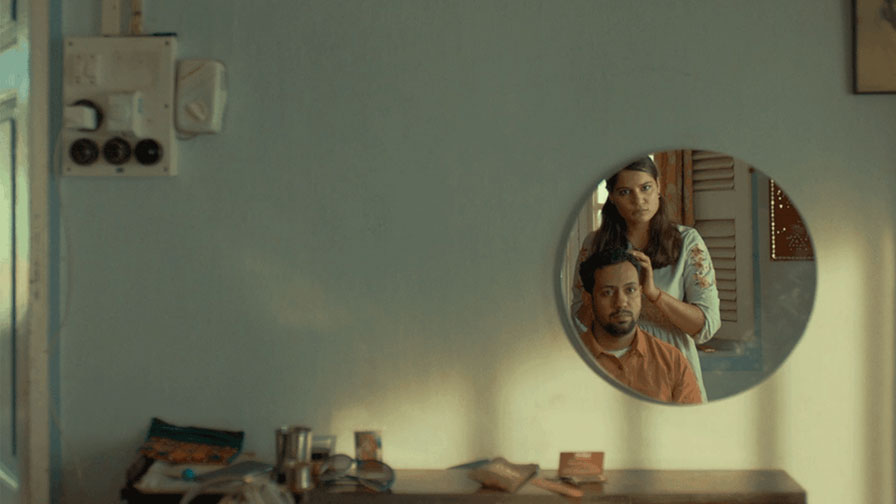Review of Anita — a short fiction film written/directed by Sushma Khadepaun
Karl Jaspers defines boundary situations in which real situations become all-encompassing or transcendental situations. Gilles Deleuze in his Cinema books, pronounces limit-images as Jasperian boundary situations in which a situation or action becomes transcendental. Situation and actions resolve into one another to form the continuity of movement i.e. the cinematograph: a writing with movement and sounds.
It is curious to think about the relationship between faciality (ie the use of the face by the actor) and limit-images and how they contribute to one another. The transcendental film-makers (like Yasujiro Ozu) emphasise a single, static expression on the face of the actor so as to emphasise the sthayi-bhava or established emotion of the shot. Contrarily the neo-realist film makers, Satyajit Ray being the chief case here, emphasise the close-up to capture a transformation in expression in the face of the actor.
I wish to emphasise two spirals of consciousness through which the action-image; where the character is forced to act, suggests. The ascending spiral leads to a dissolution of the Self (sattva), whereas the descending spiral leads to pathology (tamas). In Sushma Khadepaun’s Anita this approach to the Self single-handedly encompasses the spiritual and pathological.
The film begins with the shot of the modern protagonist entering the feudal space. Both Anita and Vikram are held together in the same frame. As they chant the words of the aarti, we see all the characters holding a single facial expression.
The feudal space appropriates the role of the woman as to beget offspring whereas the modern space emphasise a split into people (irrespective of gender) as having jobs and not having jobs. This produces the fundamental question of Anita: is the function of the woman to be equal to the man; or is it to be an agent of patriarchy?
This rift between tradition and modernity produces images of pure time since the sensory-motor link that binds movement together have been broken by a problem. This problem is not the Deleuzean crisis in representation following the Holocaust but a historical situation in which the role of the woman has transformed in a patriarchy that is not open to movement. Mani Kaul’s argument is primarily that this rift creates a collapse between a spatio-temporal object and its socio-historical context, giving way to a new object. What is Khadepaun’s view on this spatio-temporal object?
Khadepaun’s visuals emphasise theatricality along with mirrors as splitting the actual into the virtual. Mirrors also emphasise the formation of the Self as an understanding of One-self as Other. Anita and Vikram are seen in the same mirror in the opening sequence: equi-distant virtual images of one another. The transformation-of-the-object is seen in the final sequence where Vikram is in the real time-image regime whereas Anita is still in the virtual. Khadepaun’s film does not function through shot counter-shot. Instead she emphasises a master shot isolating Anita in the reverse shot. This emphasis on resemblance (Vikram and the patriarchal father look similar) is countered by a divergent dialogue which refuses to admit the new formation; i.e. women in the work space as being equal to men.
Anita is systematically dressed in the regime of the traditional idiom and then is stripped of this coding until she is eventually sexual abducted. The film uses shot counter shot only to emphasise regimes of patriarchy and the isolated woman. Very often the patriarch and mother figure are placed in the same frame to emphasise how older women are also agents of patriarchy. Modernity is the purely temporal outside that appears to enter the logic of the imbalanced development of the feudal. The question is not of the non-resemblance between a spiritual and material problem but about how a material problem and its imbalanced growth create a spiritual progression through the cinematograph.
This “spiritual progression” is represented by the shot of the gaseous perception following the abduction scene to emphasise a dissolution of the Self. The Big Other has been violated in the pathological descending regime of the action-image (tamas) whilst the cinematograph has created a disappearance of the Self so that there is no centre or periphery.
The iconic closing sequences set to the wedding song emphasise the nature of kitsch as being everyday violence crystallised into sounds best represented by popular Hindi cinema. Khadepan returns her protagonist back to the theatre of mommy-daddy-me from the desiring production of the purely cinematographic; until we see a transformation in the actor’s expression to show a transformation of the object whist she is as yet static.






Leave a Reply
You must be logged in to post a comment.